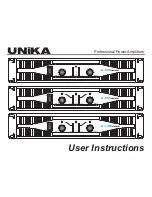
Copyright © 2019 AudioNote Kits
www.AudioNoteKits.com
[email protected]
Page 10
normally, the voltage rating of the supplied capacitors will be exactly what you see on the
parts lists. Occasionally, a part may be supplied with a higher voltage. Think nothing of it!
1.4.5 Electrolytic Capacitors
For those who have not built a piece of electronics before, here is a little lesson on capacitors.
There are basically two types of capacitors that we use in the kits: electrolytic and signal
capacitors. Of these, electrolytic capacitors require special attention. Electrolytic capacitors
are “polarized,” which means they have a POSITIVE (+) and a NEGATIVE (–) lead and typically
have values like 100uf 450V, 10uf 160V, or 470uf 35V.
These capacitors need to be installed
correctly or else they will possibly blow up at some point!
Each electrolytic capacitor will have a
wide stripe
on the NEGATIVE side. Always ensure that
this stripe (NEGATIVE) is positioned correctly. There are several keys on a printed circuit
board to help you to know how to position the capacitor:
1. There may be a "+" on the board indicating where to position the POSITIVE lead.
2. The segmented half of the circular stencil on the board shows where to position the
NEGATIVE lead. The unsegmented ('half-moon') part of the circle is where the POSITIVE
lead goes.
3. The POSITIVE lead goes to a square solder pad while the NEGATIVE lead goes to a round
solder pad.
1.4.6 Diodes
When installing diodes note that they are oriented with a stripe —
match the stripe on the
diode with the banding (||) stencil on the board.
1.4.7 Hardware/Mechanical
Not all of us are mechanically oriented. So, the kit is well laid out such that all the hardware is
provided and bagged in individual sections, so things should make sense. Start thinking
mechanically because about a third of the kit is mechanical. The first thing to remember is
that good hardware is beautiful: we use all stainless steel metric hardware in the kits. It truly
is a thing of beauty: don’t rush your hardware! Here are a few helpful things to understand:
We use British metric hardware (M3, M4, M5, screw size 10mm, 15mm, etc..) as opposed
to the American imperial system (5/1000th or 50/1000th, 1 inch, 3/4 inch). Please
familiarize yourself with the hardware in the kit.
The screws will be called M3 or M4, which is the diameter of the shaft. The length of the
shaft will be in millimeters, so you will encounter things like an M4 screw 16mm, a PAN
head screw (which is a round spherical head), or a COUNTERSUNK or FLAT head screw
(a screw head that needs to be flush with a surface — for example, under a
transformer). So if you are asked to use an M3 16mm CSK screw, this is an M3 size











































